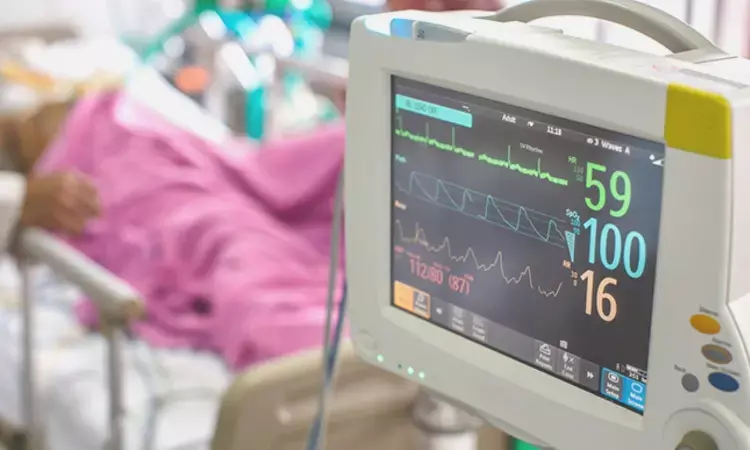- Home
- Medical news & Guidelines
- Anesthesiology
- Cardiology and CTVS
- Critical Care
- Dentistry
- Dermatology
- Diabetes and Endocrinology
- ENT
- Gastroenterology
- Medicine
- Nephrology
- Neurology
- Obstretics-Gynaecology
- Oncology
- Ophthalmology
- Orthopaedics
- Pediatrics-Neonatology
- Psychiatry
- Pulmonology
- Radiology
- Surgery
- Urology
- Laboratory Medicine
- Diet
- Nursing
- Paramedical
- Physiotherapy
- Health news
- Fact Check
- Bone Health Fact Check
- Brain Health Fact Check
- Cancer Related Fact Check
- Child Care Fact Check
- Dental and oral health fact check
- Diabetes and metabolic health fact check
- Diet and Nutrition Fact Check
- Eye and ENT Care Fact Check
- Fitness fact check
- Gut health fact check
- Heart health fact check
- Kidney health fact check
- Medical education fact check
- Men's health fact check
- Respiratory fact check
- Skin and hair care fact check
- Vaccine and Immunization fact check
- Women's health fact check
- AYUSH
- State News
- Andaman and Nicobar Islands
- Andhra Pradesh
- Arunachal Pradesh
- Assam
- Bihar
- Chandigarh
- Chattisgarh
- Dadra and Nagar Haveli
- Daman and Diu
- Delhi
- Goa
- Gujarat
- Haryana
- Himachal Pradesh
- Jammu & Kashmir
- Jharkhand
- Karnataka
- Kerala
- Ladakh
- Lakshadweep
- Madhya Pradesh
- Maharashtra
- Manipur
- Meghalaya
- Mizoram
- Nagaland
- Odisha
- Puducherry
- Punjab
- Rajasthan
- Sikkim
- Tamil Nadu
- Telangana
- Tripura
- Uttar Pradesh
- Uttrakhand
- West Bengal
- Medical Education
- Industry
Routine use of driving pressure-guided ventilation not favorable in lung resection surgery

South Korea: A driving pressure-guided ventilation in patients undergoing lung resection surgery intraoperatively improved pulmonary mechanics but did not lower the risk of postoperative pulmonary complications than conventional protective ventilation, claims a study in the British Journal of Anaesthesia.
Airway driving pressure is easily measured as plateau pressure minus PEEP, which is a surrogate for alveolar stress and strain. Alveolar stress during mechanical ventilation can cause barotrauma leading to postoperative pulmonary complications. However, there is no clarity on the effects of its targeted reduction.
Considering the above, Hyun Joo Ahn, Sungkyunkwan University School of Medicine, Seoul, South Korea, and colleagues aimed to determine whether a strategy using systematic alveolar recruitment and individualized PEEP titration to minimize airway driving pressure (driving pressure-guided ventilation) would reduce pulmonary complications within the first 7 postoperative days versus a conventional protective ventilation regimen with fixed PEEP (5 cm H2O) in lung resection surgery.
For this purpose, the researchers included patients undergoing lung resection surgery in the multicentre trial. They were randomized to either a driving pressure group (n=650) receiving an alveolar recruitment/individualized PEEP to deliver the lowest driving pressure or to a conventional protective ventilation group (n=650) with a fixed PEEP of 5 cm H2O. The study's primary outcome was a composite of pulmonary complications within 7 days postoperatively.
Based on the study, the researchers found the following:
- The modified intention-to-treat analysis included 1170 patients (mean age, 63).
- The mean driving pressure was 7.1 cm H2O in the driving pressure group vs 9.2 cm H2O in the protective ventilation group.
- The incidence of pulmonary complications was not different between the two groups: the driving pressure group (40.5%) vs the protective ventilation group (42.8%).
- Intraoperatively, lung compliance (mean, 42.7 vs 33.5 ml cm H2O−1) and Pao2 < pao2(median > vs 19.5 kPa) were higher and the need for rescue ventilation was less frequent (6.8% vs 10.8%) in the driving pressure group.
"Our findings do not support the routine use of driving pressure-guided ventilation in patients with lung resection surgery for the purpose of lowering pulmonary complications," the authors wrote. "However, further studies of driving pressure guided ventilation for high-risk patients and in other surgical populations is warranted."
Reference:
Park M, Yoon S, Nam JS, Ahn HJ, Kim H, Kim HJ, Choi H, Kim HK, Blank RS, Yun SC, Lee DK, Yang M, Kim JA, Song I, Kim BR, Bahk JH, Kim J, Lee S, Choi IC, Oh YJ, Hwang W, Lim BG, Heo BY. Driving pressure-guided ventilation and postoperative pulmonary complications in thoracic surgery: a multicentre randomised clinical trial. Br J Anaesth. 2022 Aug 19:S0007-0912(22)00367-1. doi: 10.1016/j.bja.2022.06.037. Epub ahead of print. PMID: 35995638.
Dr Kamal Kant Kohli-MBBS, DTCD- a chest specialist with more than 30 years of practice and a flair for writing clinical articles, Dr Kamal Kant Kohli joined Medical Dialogues as a Chief Editor of Medical News. Besides writing articles, as an editor, he proofreads and verifies all the medical content published on Medical Dialogues including those coming from journals, studies,medical conferences,guidelines etc. Email: drkohli@medicaldialogues.in. Contact no. 011-43720751


